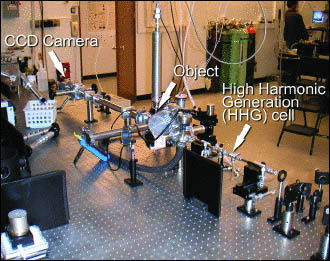
Tabletop Source Offers Extreme Ultraviolet
Paula M. Powell
Generating laserlike beams of x-rays from a simple tabletop setup, a team based at the University of Colorado's JILA in Boulder has demonstrated the ability to perform extreme-ultraviolet holography.
"Lasers in the visible region of the spectrum can be focused to extremely small spot sizes on the order of the wavelength of light and can also be used to write holograms," said researcher Margaret M. Murnane. "In the past, these capabilities were available at very short wavelengths, in the extreme-ultraviolet region, only by spatially filtering the source, resulting in significant energy loss."

A tabletop system for generating extreme-ultraviolet radiation may find applications in holography and precision metrology. The high-harmonic-generation cell, a 10-cm-long hollow-core fiber filled with argon gas, converts 25-fs pulses of 760-nm radiation from a Ti:sapphire laser into extreme-UV radiation. Courtesy of Margaret M. Murnane and Henry C. Kapteyn.
The JILA scientists used a very simple setup to demonstrate holography at the EUV wavelengths. In the future, they hope to apply their EUV source for time-resolved holography within biological cells without having to dry them. Although similar capabilities are possible with synchrotron technology, the new technique offers extremely high time resolution and compact size in comparison.
The JILA system generates spatially coherent EUV radiation through high-harmonic up-conversion of a femtosecond laser. Its footprint, including laser, x-ray-generation cell, imaging setup and CCD camera, is only 100 x 350 cm. Other EUV lasers are more powerful, Murnane said, but the light resulting from high-harmonic generation with these sources is not as collimated, short in duration, focusable or spatially coherent. The tabletop system has such a high beam quality that, depending on its configuration, end users could focus the resulting light 20 to 30 times smaller in diameter than a helium-neon laser. That beam would also have peak intensities about 10 orders of magnitude high-er (with comparable average intensities).
The high beam quality arises from the use of a gas-filled, hollow waveguide to generate the EUV. In a technique first demonstrated by the JILA scientists in 1998, they focus an intense femtosecond laser into the hollow fiber, where the laser field literally rips atoms apart. During this catastrophic ionization process, the system emits coherent EUV radiation, which they monitor.
In past research work, they demonstrated that the conversion efficiency from visible laser light into EUV radiation is two orders of magnitude higher than is possible with a free-space focusing configuration. The current research illustrates that this experimental setup also improves beam divergence and spatial coherence. The reason is simple: The technique only phase-matches the emission of atoms that contribute to fully coherent forward-directed light.
Murnane and her colleagues recently demonstrated the tabletop light source by recording and reconstructing simple Gabor holograms of a near-field scanning optical microscopy tip and a 10-µm- diameter water jet. The scientists say that although the resolution in these initial images is only around 7 to 8 µm, improvement is possible with the use of increased detector resolution, a larger geometric magnification or optical magnification with an EUV optic. They believe that high spatial coherence combined with low divergence also will make the extreme-UV light source useful in applications involving the inspection of optical components for EUV lithography and other precision metrology tasks requiring nanometer resolution.
Published: September 2002